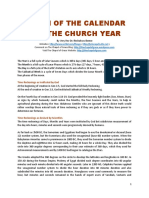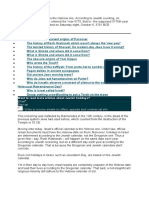0 ratings0% found this document useful (0 votes)
29 viewsA History of The New Year
A History of The New Year
Uploaded by
KCopyright:
© All Rights Reserved
Available Formats
Download as DOCX, PDF, TXT or read online from Scribd
A History of The New Year
A History of The New Year
Uploaded by
K0 ratings0% found this document useful (0 votes)
29 views2 pagesOriginal Title
A History Of the New Year
Copyright
© © All Rights Reserved
Available Formats
DOCX, PDF, TXT or read online from Scribd
Share this document
Did you find this document useful?
Is this content inappropriate?
Copyright:
© All Rights Reserved
Available Formats
Download as DOCX, PDF, TXT or read online from Scribd
Download as docx, pdf, or txt
0 ratings0% found this document useful (0 votes)
29 views2 pagesA History of The New Year
A History of The New Year
Uploaded by
KCopyright:
© All Rights Reserved
Available Formats
Download as DOCX, PDF, TXT or read online from Scribd
Download as docx, pdf, or txt
You are on page 1of 2
A History of the New Year
by Borgna Brunner
From ancient celebrations in Mesopotamia to modern day
traditions, read this article to learn about the history of the New
Year.
A Move from March to January
The earliest recording of a new year celebration is believed to
have been in Mesopotamia, c. 2000 B.C. and was celebrated
around the time of the vernal equinox, in mid-March. A variety of
other dates tied to the seasons were also used by various ancient
cultures. The Egyptians, Phoenicians, and Persians began their
new year with the fall equinox, and the Greeks celebrated it on
the winter solstice.
Early Roman Calendar: March 1st Rings in the New Year
The early Roman calendar designated March 1 as the new year.
The calendar had just ten months, beginning with March. That the
new year once began with the month of March is still reflected in
some of the names of the months. September through December,
our ninth through twelfth months, were originally positioned as
the seventh through tenth months (septem is Latin for "seven,"
octo is "eight," novem is "nine," and decem is "ten."
January Joins the Calendar
The first time the new year was celebrated on January 1st was in
Rome in 153 B.C. (In fact, the month of January did not even exist
until around 700 B.C., when the second king of Rome, Numa
Pontilius, added the months of January and February.) The new
year was moved from March to January because that was the
beginning of the civil year, the month that the two newly elected
Roman consuls-the highest officials in the Roman republic-began
their one-year tenure. But this new year date was not always
strictly and widely observed, and the new year was still
sometimes celebrated on March 1.
Julian Calendar: January 1st Officially Instituted as the
New Year
In 46 B.C. Julius Caesar introduced a new, solar-based calendar
that was a vast improvement on the ancient Roman calendar,
which was a lunar system that had become wildly inaccurate over
the years. The Julian calendar decreed that the new year would
occur with January 1, and within the Roman world, January 1
became the consistently observed start of the new year.
Middle Ages: January 1st Abolished
In medieval Europe, however, the celebrations accompanying the
new year were considered pagan and unchristian like, and in 567
the Council of Tours abolished January 1 as the beginning of the
year. At various times and in various places throughout medieval
Christian Europe, the new year was celebrated on Dec. 25, the
birth of Jesus; March 1; March 25, the Feast of the Annunciation;
and Easter.
Gregorian Calendar: January 1st Restored
In 1582, the Gregorian calendar reform restored January 1 as New
Year’s Day. Although most Catholic countries adopted the
Gregorian calendar almost immediately, it was only gradually
adopted among Protestant countries. The British, for example, did
not adopt the reformed calendar until 1752. Until then, the British
Empire -and their American colonies- still celebrated the new year
in March.
You might also like
- A History of The New YearDocument2 pagesA History of The New YearMarjan Trajkovic100% (1)
- Egyptian Religious Calendar-CDXIII Great Year of Ra Wp-RenepetDocument23 pagesEgyptian Religious Calendar-CDXIII Great Year of Ra Wp-RenepetRafael Ramesses75% (4)
- How Old is the World the Byzantine Era Κατὰ Ῥωμαίους and Its RivalsDocument5 pagesHow Old is the World the Byzantine Era Κατὰ Ῥωμαίους and Its RivalsAnita TheredNo ratings yet
- DBM-DILG-NYC JMC NoDocument34 pagesDBM-DILG-NYC JMC NoManuel Nieves Lumaday100% (1)
- System Operations Training Manual 5-27-2015Document247 pagesSystem Operations Training Manual 5-27-2015sulemankhalid100% (1)
- Exposición Ingles - ChristmasDocument18 pagesExposición Ingles - ChristmasGregoriCañasNo ratings yet
- newyear decemberDocument3 pagesnewyear decemberderkuzestaNo ratings yet
- Coptic CalenderDocument29 pagesCoptic CalenderRicardo Kuptios100% (1)
- Calendars and Assumptions: Hebrew For ChristiansDocument5 pagesCalendars and Assumptions: Hebrew For ChristiansShanica Paul-RichardsNo ratings yet
- The Moon and Planets in Ancient MesopotamiaDocument29 pagesThe Moon and Planets in Ancient MesopotamialaveshworkNo ratings yet
- AloyDocument2 pagesAloyroman232323No ratings yet
- Origin of Names of Days Sunday Monday Tuesday Wednesday Thursday Friday SaturdayDocument9 pagesOrigin of Names of Days Sunday Monday Tuesday Wednesday Thursday Friday Saturdayjoydeep_d3232No ratings yet
- Origin of The Calendar and The Church YearDocument7 pagesOrigin of The Calendar and The Church YearIfechukwu U. IbemeNo ratings yet
- New Year Is The: Time Calendar Year Year CountDocument1 pageNew Year Is The: Time Calendar Year Year CountAndrius ŽaliaduonisNo ratings yet
- UntitledDocument2 pagesUntitledAzakah IbrahimNo ratings yet
- Related Articles: Want To Read More Articles About Jewish Holidays?Document5 pagesRelated Articles: Want To Read More Articles About Jewish Holidays?shibly anastasNo ratings yet
- Months of The Jewish YearDocument28 pagesMonths of The Jewish YearBayan Chem-boy MnnahNo ratings yet
- 4 of July, Star Sirius, Yahweh, and The Vedic NakshatrasDocument18 pages4 of July, Star Sirius, Yahweh, and The Vedic NakshatrasEce AyvazNo ratings yet
- Byzantine CalendarDocument16 pagesByzantine CalendarFilip100% (1)
- Days and MonthsDocument3 pagesDays and MonthsDiphilusNo ratings yet
- Gsutjiawan OriginshighschoolDocument2 pagesGsutjiawan Originshighschoolapi-459345812No ratings yet
- History of CalendarsDocument12 pagesHistory of Calendarsjohn100% (1)
- The Ethiopic Calendar - Dr. Aberra MollaDocument8 pagesThe Ethiopic Calendar - Dr. Aberra MollagirmeshNo ratings yet
- New Year Celebrations - Are They For ChristiansDocument3 pagesNew Year Celebrations - Are They For ChristiansPeter CarrollNo ratings yet
- Time Days Months SeasonsDocument6 pagesTime Days Months SeasonsBalint PaulNo ratings yet
- Jewish CalendarDocument5 pagesJewish Calendarapi-259626831No ratings yet
- NewyearrrDocument3 pagesNewyearrrderkuzestaNo ratings yet
- Dionysius Exiguus and The Introduction of The Christian EraDocument82 pagesDionysius Exiguus and The Introduction of The Christian EraneddyteddyNo ratings yet
- Correspondence Course Lesson 11 - The Biblical CalendarDocument12 pagesCorrespondence Course Lesson 11 - The Biblical CalendarFred BwasiemuNo ratings yet
- Calendar: HistoryDocument27 pagesCalendar: HistorysurbcNo ratings yet
- Jewish CalendarDocument9 pagesJewish CalendarRecuperatedbyJesusNo ratings yet
- Historical Financial Statistics: Calendar NotesDocument13 pagesHistorical Financial Statistics: Calendar NotesBrock TernovNo ratings yet
- MonthDocument7 pagesMonthChandni ViraniNo ratings yet
- History of The CalendarDocument4 pagesHistory of The Calendaranon-500003No ratings yet
- Lunar CalendarsDocument9 pagesLunar CalendarsGary WadeNo ratings yet
- Panchanga IntroductionDocument16 pagesPanchanga IntroductionSandhya KadamNo ratings yet
- Roman Calendar (Wikipedia)Document12 pagesRoman Calendar (Wikipedia)ThriwNo ratings yet
- 0 (Year) : Counting Intervals Without A ZeroDocument9 pages0 (Year) : Counting Intervals Without A ZeroAnonymous OuZdlENo ratings yet
- Ancient Jewish Calendation - Grace AmadonDocument53 pagesAncient Jewish Calendation - Grace AmadonbrianwillardNo ratings yet
- Moses The Pleiades and The Nebra Sky DiskDocument15 pagesMoses The Pleiades and The Nebra Sky Diskputzer19669100% (2)
- Babylonian CalendarDocument4 pagesBabylonian Calendarprevo015100% (1)
- Months Named After Fallen AngelsDocument6 pagesMonths Named After Fallen AngelsJesus LivesNo ratings yet
- What Is So Right About The Hindu CalendarDocument9 pagesWhat Is So Right About The Hindu CalendarRakhi PatwaNo ratings yet
- Reconstruction of Pre-Metonic Hebrew Calendar PDFDocument10 pagesReconstruction of Pre-Metonic Hebrew Calendar PDFrforteza100% (1)
- Jesus Chronology of LifeDocument17 pagesJesus Chronology of LifeRazvan ArdeleanNo ratings yet
- Babylonian Calendar and The BibleDocument2 pagesBabylonian Calendar and The BibleLeeUnderNo ratings yet
- The Liturgical Calendar and Church Ceremonies ADocument25 pagesThe Liturgical Calendar and Church Ceremonies AAdebola Omodunnbi IloriNo ratings yet
- Acts History of The CalendarDocument2 pagesActs History of The CalendarAngelina Beatriz ClaveriaNo ratings yet
- neewyear augustDocument3 pagesneewyear augustderkuzestaNo ratings yet
- A History of The MonthsDocument4 pagesA History of The MonthsMuhammed Surajudeen Olasupo AminuNo ratings yet
- The Calendars of Ancient Egypt: BCE BCEDocument22 pagesThe Calendars of Ancient Egypt: BCE BCERobert DavisNo ratings yet
- Zodiac Entry 1Document1 pageZodiac Entry 1api-476194324No ratings yet
- The First Visible Crescent Does NOT Announce The New MoonDocument6 pagesThe First Visible Crescent Does NOT Announce The New MoonCraig KirkNo ratings yet
- Siegfried H. Horn & Lynn H. Wood - The Chronology of Ezra 7Document65 pagesSiegfried H. Horn & Lynn H. Wood - The Chronology of Ezra 7jotyntteologo25100% (3)
- ReportDocument6 pagesReportJayr LimtuacoNo ratings yet
- Indian CalendarDocument49 pagesIndian Calendararavindiyengar1977No ratings yet
- Istory of The Months and The Meanings of Their NamesDocument10 pagesIstory of The Months and The Meanings of Their NamesjardelNo ratings yet
- Calendar IntroDocument9 pagesCalendar IntroMarceloNo ratings yet
- The Ethiopic CalendarDocument10 pagesThe Ethiopic CalendarYonasNo ratings yet
- Thermal Energy 1Document22 pagesThermal Energy 1patrick clarkeNo ratings yet
- Prospectus-Remedies For MisrepresentationDocument4 pagesProspectus-Remedies For Misrepresentationvlogssunny870No ratings yet
- Devops Brochure - H-Town TechnologiesDocument4 pagesDevops Brochure - H-Town TechnologiesMohammed ImamuddinNo ratings yet
- PEA's Weekly Model Test Result: S.N. Student's Name Group FM Marks % Rank RemarksDocument53 pagesPEA's Weekly Model Test Result: S.N. Student's Name Group FM Marks % Rank Remarksdivyanshusahcocd22No ratings yet
- Reopening Hawaii's EconomyDocument18 pagesReopening Hawaii's EconomyHNN100% (3)
- Indian CfoDocument2 pagesIndian CfoSmruti RanjanNo ratings yet
- Theories of GlobalizationDocument25 pagesTheories of GlobalizationJosebeth Cairo100% (1)
- R&P RULES - GENERAL PRINCIPLES (Revised 08 - 2010Document106 pagesR&P RULES - GENERAL PRINCIPLES (Revised 08 - 2010kunal100% (1)
- 2021 2022 ResumeDocument2 pages2021 2022 Resumeapi-282594383No ratings yet
- BRC Audit ReportDocument22 pagesBRC Audit ReportPhuong NguyenNo ratings yet
- SSEI Write UP EnglishDocument1 pageSSEI Write UP EnglishSunil ShrivastavNo ratings yet
- CIR Vs Inter PublicDocument3 pagesCIR Vs Inter PublicArrianne ObiasNo ratings yet
- Lac 2022Document8 pagesLac 2022Ngọc Bảo HânNo ratings yet
- BS 4875-5 2009 Strength and Stability of FurnitureDocument18 pagesBS 4875-5 2009 Strength and Stability of Furniturealan-chuah-7423No ratings yet
- Withholding TaxDocument18 pagesWithholding TaxshreyoseegoswamiNo ratings yet
- Offer LetterDocument3 pagesOffer Letterjabberwocky13589No ratings yet
- 6 14 Notice: Before The Expiry Date of Strike During PendencyDocument37 pages6 14 Notice: Before The Expiry Date of Strike During PendencySWARNABH .No ratings yet
- EskedDocument42 pagesEskedGirma Uniqe100% (1)
- Imc Project On Coca ColaDocument15 pagesImc Project On Coca ColaAnkkit PandeyNo ratings yet
- Reviewer-Spcl Rules AdrDocument22 pagesReviewer-Spcl Rules Adrjeseth_deveraNo ratings yet
- Examen 4 EsoDocument2 pagesExamen 4 EsoNoemí Martínez Delgado0% (2)
- Gujarat-Textile-Policy-2024(crated by yuvraj )Document8 pagesGujarat-Textile-Policy-2024(crated by yuvraj )krishbhavsar69No ratings yet
- Khewata Dam Comments 10Document1 pageKhewata Dam Comments 10Radu MarinescuNo ratings yet
- Aci Multi Site Pod f5 Ip Design GuideDocument46 pagesAci Multi Site Pod f5 Ip Design GuideJoshua LimakweNo ratings yet
- Kentucky Swing Hardees Revised 1862 ManualDocument4 pagesKentucky Swing Hardees Revised 1862 Manualapi-248961229No ratings yet
- Shop Cinq À Sept Sierra Wrap Minidress Saks Fifth AvenueDocument1 pageShop Cinq À Sept Sierra Wrap Minidress Saks Fifth AvenueverodsalazarNo ratings yet
- Problems and Current Issues in Philippine Education On k12 Curriculum IIDocument30 pagesProblems and Current Issues in Philippine Education On k12 Curriculum IIPerry Arcilla SerapioNo ratings yet
- Republic Vs Dela PazDocument13 pagesRepublic Vs Dela PazJupert Jericho Mercader RemolloNo ratings yet
- When Is A Notice of Donation Needed?: NEDA - National Economic Development AuthorityDocument4 pagesWhen Is A Notice of Donation Needed?: NEDA - National Economic Development AuthorityJonabelle BiliganNo ratings yet

























































































